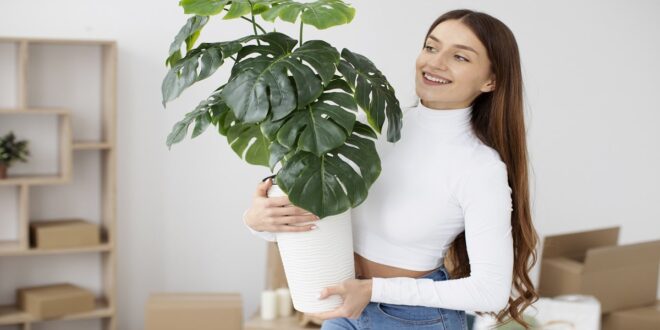Indoor plants are a great addition to any home, not only for their aesthetic value but also for the numerous health benefits they offer. However, just like any other living thing, plants need proper care to thrive.
Repotting indoor plants is an essential part of plant care that can sometimes be overlooked. In this article, we will discuss the best tips for beginners on how to repot indoor plants.
Plants that You Should Not Forget to Repot
While most indoor plants will benefit from repotting every year or so, there are some plants that require more frequent repotting to thrive. Here are a few plants that you should not forget to repot:
- Prayer Plant: The prayer plant (Maranta leuconeura) is a popular houseplant known for its striking foliage and low maintenance. However, it is also a fast-growing plant that will quickly outgrow its pot if not repotted regularly. Repot prayer plants every six months to keep them healthy and avoid root-bound conditions.
When repotting prayer plants, make sure to use a pot that is one size larger than the previous pot and use a well-draining potting mix. This will provide the plant with the necessary nutrients and moisture for healthy growth. Be careful not to damage the roots when repotting, as prayer plants are sensitive to root disturbance.
- Spider Plant: The spider plant (Chlorophytum comosum) is a popular indoor plant known for its air-purifying qualities and easy care. However, it is also a plant that quickly becomes root-bound and requires repotting every year or so.
When repotting spider plants, choose a pot that is one size larger than the previous pot and use a well-draining potting mix.
Be sure to loosen the roots carefully and remove any dead or damaged roots before repotting. Water the plant thoroughly after repotting and keep it out of direct sunlight for a few days to avoid stress.
- Pothos: Pothos (Epipremnum aureum) is a popular trailing plant that is often used in hanging baskets or as a climbing plant. It is a fast-growing plant that requires regular repotting to maintain healthy growth.
When repotting pothos, choose a pot that is one size larger than the previous pot and use a well-draining potting mix. Be sure to loosen the roots carefully and remove any dead or damaged roots before repotting. Water the plant thoroughly after repotting and keep it out of direct sunlight for a few days to avoid stress.
By keeping these plants in mind and repotting them regularly, you can ensure they stay healthy and continue to thrive in your home.
Why Repotting Indoor Plants is Important

Repotting indoor plants is important for their overall health and growth. Over time, the potting soil that your plant is growing in will start to break down, making it harder for the plant to get the nutrients it needs.
Additionally, as the plant grows, its roots will outgrow the pot and become root-bound, making it harder for the plant to absorb water and nutrients. Repotting indoor plants helps to replenish the soil, provide more space for root growth, and give the plant a fresh start.
When to Repot Indoor Plants
The frequency of repotting indoor plants varies depending on the plant species and potting soil used. However, a general rule of thumb is to repot your indoor plants every 1-2 years. Signs that your indoor plants need repotting include roots growing out of the drainage holes, slow growth or stunted growth, and the soil drying out too quickly.
Signs that Your Indoor Plants Need Repotting
One of the most obvious signs that your indoor plant needs repotting is when the roots start growing out of the drainage holes. This is a clear indication that the plant has outgrown its pot and needs more space for root growth.
Another sign is slow growth or stunted growth. If your plant is not growing as quickly as it used to, it may be time to repot. Finally, if the soil is drying out too quickly and your plant is requiring more frequent watering, it may be time to repot.
How to Choose the Right Pot for Repotting Indoor Plants
Choosing the right pot for repotting indoor plants is crucial for the plant’s health and growth. The pot should be slightly larger than the current pot but not too big, as this can lead to overwatering and root rot.
The material of the pot is also important, as some materials like terracotta are porous and can lead to faster soil drying. The pot should also have adequate drainage holes to prevent water from pooling at the bottom and causing root rot.
Materials Needed For Repotting Indoor Plants
Before you start repotting your indoor plants, make sure you have all the necessary materials on hand. You will need potting soil, fertilizer, pruning shears, and a trowel. Potting soil is specially formulated for indoor plants and provides the necessary nutrients and drainage for healthy growth.
Fertilizer is also important for providing essential nutrients to the plant, especially after the shock of repotting. Pruning shears will be needed to trim any damaged or overgrown roots, and a trowel is necessary for scooping soil into the new pot.
Steps to Follow When Repotting Indoor Plants
1. Preparing the new pot: Before you start repotting, prepare the new pot by adding a layer of fresh potting soil to the bottom.
2. Removing the plant from the old pot: Carefully remove the plant from its old pot by gently pulling on the base of the stem while holding the pot.
3. Teasing out the roots: Once the plant is out of the pot, gently tease out the roots with your fingers or a trowel. Trim any damaged or overgrown roots with pruning shears.
4. Adding fresh soil to the new pot: Add fresh potting soil to the new pot, filling it up to about one-third of the way.
5. Placing the plant in the new pot: Place the plant in the new pot, making sure it is centered and at the same depth as it was in the old pot.
6. Adding more soil: Add more soil around the plant until it is level with the surface of the soil in the old pot.
7. Watering and fertilizing the plant: Water the plant thoroughly after repotting and adding fertilizer according to the instructions on the package.
Aftercare for Repotted Indoor Plants
After repotting, it is important to monitor the plant for signs of stress. Water the plant regularly but avoid overwatering, as this can lead to root rot. Prune and groom the plant regularly to promote healthy growth and prevent disease.
Common Mistakes to Avoid When Repotting Indoor Plants
One common mistake when repotting indoor plants is choosing a pot that is too large. This can lead to overwatering and root rot, as the soil will retain more water than the plant needs.
Another mistake is not teasing out the roots, which can lead to the plant becoming root-bound and unable to absorb water and nutrients.
Over-watering or under-watering the plant is also a common mistake that can be avoided by monitoring the plant’s soil moisture and adjusting watering accordingly.
Conclusion
Repotting indoor plants is an important part of plant care that should not be overlooked. By following the best tips for beginners outlined in this article, you can ensure your indoor plants are healthy and thriving.
Remember to choose the right pot, use the correct materials, and follow the steps carefully to give your indoor plants a fresh start. By repotting regularly, you can enjoy the beauty and benefits of indoor plants for years to come.
 Make Home Smart Let's Make Smart Home for Everyone!
Make Home Smart Let's Make Smart Home for Everyone!




